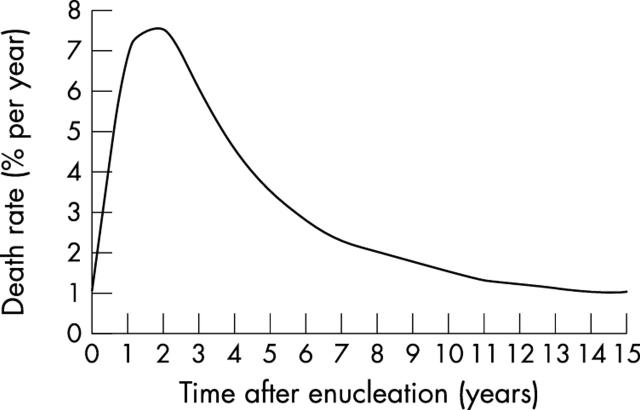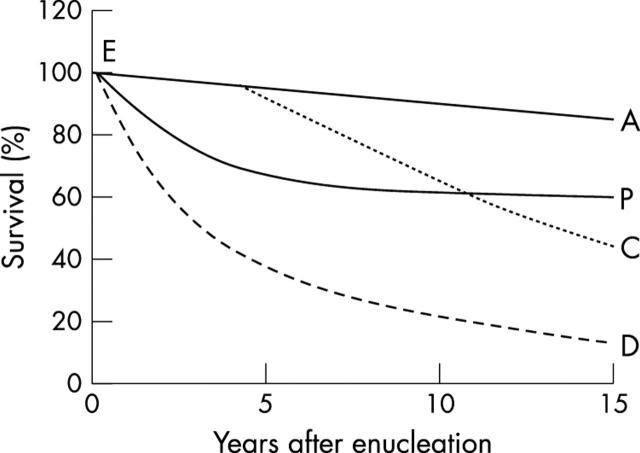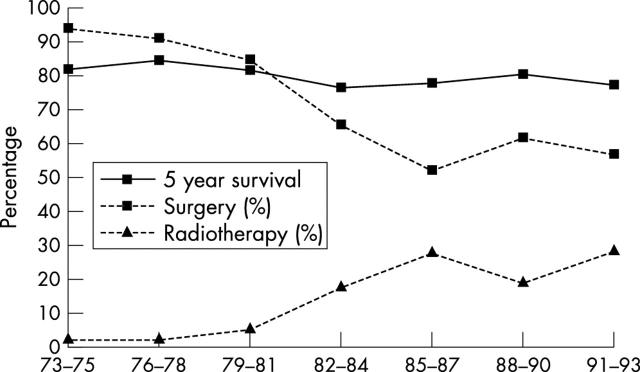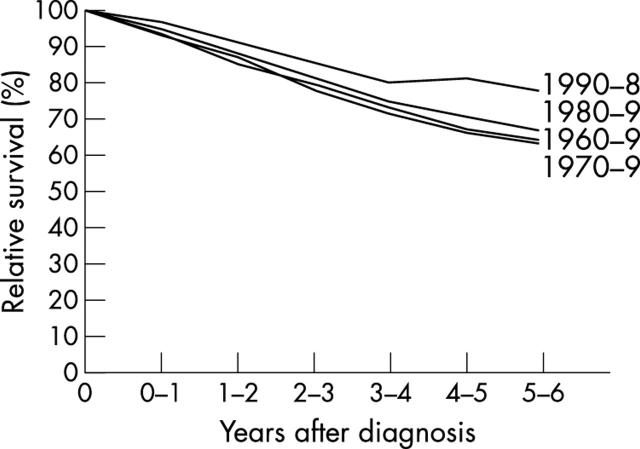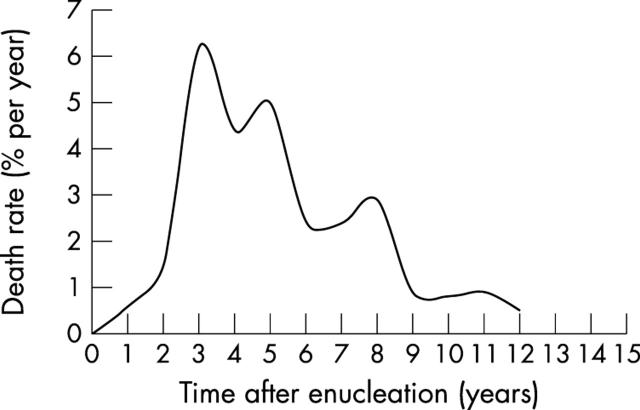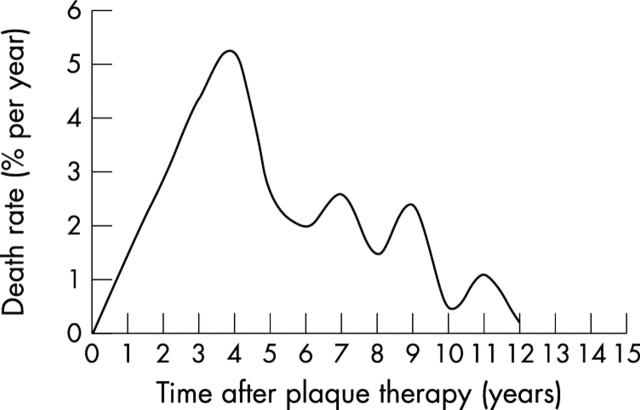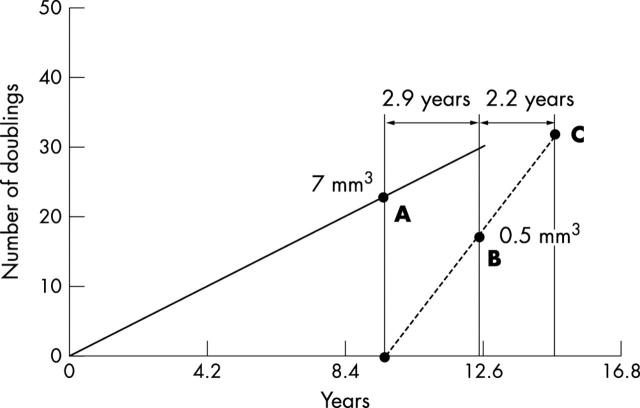Abstract
It is now 25 years since the publication of the landmark article by Zimmerman, McLean, and Foster, in which they cast doubts on the benefit of enucleation, which was the prevailing management of choroidal melanoma at that time. Over the past 25 years several advances have been made in the management of uveal melanoma. Research in the pathobiology of cancer metastasis in general and uveal melanoma in particular has also provided new insights. In this review, the Zimmerman-McLean-Foster hypothesis is explored in the light of current clinical, epidemiological, statistical, and experimental evidence.
Keywords: Zimmerman-McLean-Foster hypothesis, uveal melanoma, tumour resction
It is now 25 years since the publication of the landmark article in this journal by Lorenz E Zimmerman, Ian W McLean, and Walter D Foster entitled “Does enucleation of the eye containing a malignant melanoma prevent or accelerate the dissemination of tumour cells.”1 In that article and two other subsequent publications,2,3 the authors put forward a hypothesis which cast doubts on the benefit of enucleation as a treatment of the primary tumour, which was the prevailing management of choroidal melanoma at that time. Their work was in fact an impetus to the development of alternative therapy for uveal melanoma including various forms of radiotherapy4–7 and tumour resection.8
Over the past 25 years several advances have been made in the management of uveal melanoma. Several groups have published survival data on a large number of patients managed by enucleation or other methods of treatment. In addition, survival results of the large, randomised Collaborative Ocular Melanoma Study (COMS) are now available. Research in the pathobiology of cancer metastasis in general and uveal melanoma in particular has also provided new insights.
Here, the Zimmerman-McLean-Foster hypothesis is explored in the light of current clinical, epidemiological, statistical, and experimental evidence.
ZIMMERMAN-MCLEAN-FOSTER HYPOTHESIS
The hypothesis is based on three critical components:
observation of the pattern of mortality which peaked 2–3 years after enucleation and stabilised to the pre-enucleation level by the seventh year after enucleation (fig 1)
inference that the pattern of rise in post-enucleation mortality was not compatible with the presumed natural history of uveal melanoma before enucleation (fig 2), and
suggestion that approximately two thirds of post-enucleation mortality was the result of enucleation.
Figure 1.
Annual melanoma specific mortality rate following enucleation. Reproduced with permission from Zimmerman et al.1
Figure 2.
Observed and hypothetical survival curves following enucleation for uveal melanoma. E indicates the time of enucleation. EP is observed survival curve. EA, EC, and ED are hypothetical survival curves of untreated patients. EA represents the survival curve with low and steady mortality rate of 1%. EC represents survival with moderately increased mortality rate. ED represents survival with markedly increased mortality rate. Reproduced with permission from Zimmerman et al.1
The authors based their statistical analysis on survival data of 2652 cases treated with enucleation for ciliary body and choroidal melanoma between 1925 and 1955.9 All cases had a minimum follow up of 5 years with histopathological confirmation of uveal melanoma. The tumours were classified using the Callender classification of six prognostic subtypes: spindle A, spindle B, fascicular, mixed, epithelioid, and necrotic.10
Overall mortality was 29% at 5 years, 40% at 10 years, and 45% at 15 years. Over a 15 year period, the survival rate varied with the histopathology subtype: 82% with spindle A, 74% with spindle B cell and fascicular tumours, 41% with mixed cell type and necrotic melanomas, and only 28% for patients with pure epithelioid cell type melanoma.9 The authors plotted the overall observed post-enucleation survival curve and compared it to the three hypothetical survival curves of untreated uveal melanoma: a low and steady mortality rate of 1%, moderately increasing mortality, and markedly increasing mortality (fig 2).1
As the low steady mortality rate of 1% per year could only account for 15% of all deaths in 15 years, the remaining 30% of the total 45% observed mortality was potentially attributable to enucleation. It was postulated that there was enucleation induced dissemination of tumour emboli, altered host immunological or other defence mechanisms, or both.1,2
LIMITATIONS OF THE ORIGINAL DATA
The major limitation of the hypothesis is the assumption of the natural history of the uveal melanoma made by the authors. The authors assumed that patients with untreated uveal melanoma have a low and steady mortality rate of about 1% per year. This was based on the observation that the metastasis at the time of ophthalmic diagnosis of uveal melanoma is rare. Surveys of large numbers of patients with uveal melanoma have revealed that only about 2% of cases exhibit evidence of metastasis on pretreatment systemic evaluation.11,12 These findings cannot be extrapolated to imply that untreated cases of uveal melanoma have low metastatic potential. There are anecdotal case reports where patients with untreated uveal melanoma are found to have metastasis many years after the initial diagnosis.13 Others thought that such cases reflect variations in behaviour of uveal melanoma rather than provide firm information on the natural history of the disease.
Although there have been attempts at reconstructing the natural history of uveal melanoma,14,15 at present we do not have sufficient information regarding the natural course of untreated cases of uveal melanoma. Moreover, it is unlikely we will ever obtain this information because of ethical concerns regarding conducting a randomised clinical trial comparing outcomes in treated and untreated cases of uveal melanoma.16
RECENT CLINICAL STUDIES
Mortality trends
United States
In a recent study, the trend in 5 year relative survival rates with primary uveal melanoma in the United States over a 25 year period from 1973 to 1997 was analysed.17 The data were obtained from Surveillance, Epidemiology, and End Result (SEER) programme of the National Cancer Institute, United States. The SEER programme collects data from population based cancer registries covering approximately 14% of the United States.18 Almost 160 000 new cases are accessioned each year with 98% case ascertainment.19
A total of 2054 patients with primary uveal melanoma in the database were stratified according to the treatment (surgery or radiotherapy). The relative 5 year survival was calculated by the life table method using life expectancy tables. A clear trend in the treatment of patients was seen with an increasing proportion of cases treated by radiotherapy from 2% to 28% (fig 3). However, the relative 5 year survival rate (77% to 84%) did not show any statistically significant variation.
Figure 3.
Five year relative survival rate with uveal melanoma and proportion of cases treated with surgery and radiotherapy. Reproduced with permission from Singh et al.17
Sweden
A population based national survey revealed 2997 cases of uveal melanoma in the Swedish Cancer Registry.20 These data were based on dual compulsory registration by clinician and pathologist and are believed to include more than 95% of Swedish cases from 1960 to 1998. Survival rates were calculated with the Hakulinen life table method, using the relative survival as an estimate for the deaths due to uveal melanoma because tumour death was found to be significantly underestimated by death certificates. By the end of 1998 a total of 2003 patients had died. The relative survival rate at 5 years and 10 years was 70.1% and 59.4%, respectively. Excess mortality (reflecting tumour death) peaked at 3 years and statistically significant excess mortality remained up to 5.5 years after diagnosis. In a multivariate model younger age (less than 45 years) and period of treatment (1990–8) were associated with better relative survival (fig 4). Although the 5 year relative survival rates in Sweden were significantly better in later time periods, care should be taken not to draw conclusions regarding the impact of eye sparing treatments on survival, as the patients could not be adjusted for different treatments, nor for staging of the uveal melanoma.
Figure 4.
Relative survival rates (with 95% confidence intervals) in uveal melanoma patients with regard to year at diagnosis. Reproduced with permission from Bergman et al.20
Finland
One specific feature of uveal melanoma is that it can lead to death from metastases a long time after definitive treatment of the primary tumour. In Finland, where an excellent cancer registration system has been operational since the 1950s, it has been possible to analyse very long term mortality (more than 15 years after treatment) from uveal melanoma.21 The data indicate that tumour related deaths steadily take place at least until 35 years after enucleation. It has been observed that by 5, 15, 25, and 35 years approximately 62%, 90%, 98%, and 100% of all metastatic deaths have occurred. Moreover, tumour related deaths between 15 and 35 years following treatment account for almost one third of all deaths.
Willem Manschot, a fierce critic of the Zimmerman theory, pointed out that if metastases indeed were seeded at the time of enucleation, they would probably become symptomatic much later than the peak observed between 2 and 3 years from enucleation.22 Indeed, it is quite possible that a proportion of late and very late deaths from uveal melanoma might be explained by the Zimmerman hypothesis, a point that he did not emphasise. Specifically, surgical trauma might release into the blood circulation cells that would not have spontaneously metastasised, and which would start more rapid growth only after they have become more advanced in tumour progression or when host defences weaken.23
Other alternatives to explain delayed metastasis are that metastases initially will be checked by host defences, and that some of them may be extremely slowly cycling. We cannot currently prefer any of these alternatives based on the available clinical and experimental data.
Mortality with alternative therapy
Based on several retrospective studies and one prospective study, the mortality rates for comparable sized uveal melanoma managed by enucleation, plaque radiotherapy,24–27 proton beam therapy,28 helium ion therapy,29 and resection30,31 appear to be similar (table 1).
Table 1.
Reported outcomes with alternative therapies for uveal melanoma (comparative studies)
| Author | Year | Study groups | Outcome | Rate* | |
| Adams24 | 1988 | Enucleation | 5 year tumour related mortality | 0.77–1.07 | |
| Plaque | (rate ratio) | ||||
| Seddon28 | 1990 | Enucleation | 5 year survival rate | 68% | |
| Proton beam | 81% | ||||
| Augsburger30 | 1990 | Plaque | Actuarial 5 year survival | 82% | |
| Resection | probability | 85% | |||
| Foulds8 | 1991 | Enucleation | Melanoma related mortality | 70% | |
| Resection | 76% | ||||
| Kroll29 | 1998 | Plaque | 5 year all cause mortality | 23% | |
| Helium ion | 26% | ||||
| Augsburger25 | 1999 | Enucleation | Cumulative 15 year survival | 57% | |
| Plaque | 62% | ||||
| COMS26 | 2001 | Enucleation | 5 year all cause mortality | 19% | |
| Plaque | 18% | ||||
| COMS33 | 1998 | Enucleation ± radiation | 5 year all-cause survival | 57%–62% | |
| Puusaari27 | 2003 | Plaque | 5 year all-cause survival | 62% | |
COMS, Collaborative Ocular Melanoma Study.
*Difference not statistically significant in any study.
Collaborative Ocular Melanoma Study
The Collaborative Ocular Melanoma Study (COMS) is an ongoing prospective study that is investigating the patient survival after treatment of choroidal melanoma.32 Choroidal melanomas were classified into three groups—small, medium, and large—based on basal dimension and tumour height. Tumours classified as medium sized were randomised to enucleation or iodine-125 plaque therapy26 and large choroidal melanomas were randomised to enucleation only or pre-enucleation external beam irradiation and enucleation.33
The initial mortality finding from the COMS medium sized choroidal melanoma randomised clinical trial involving 1317 patients was recently published.26 In the study, 660 patients were randomly assigned to enucleation and 657 to plaque therapy. During the follow up period of more than 11 years, 364 patients died: 188 (28%) in the enucleation group and 176 (27%) in the plaque therapy group. The estimated 5 year all-cause mortality rates of 19% and 18% were similar in two groups. Similarly, 5 year melanoma specific mortality of 11% and 9% did not differ significantly between the two groups. The COMS findings indicate that the method of treatment (enucleation and plaque therapy) does not have a significant bearing on the incidence of metastasis in medium sized choroidal melanoma. Similarly for 801 patients enrolled in the large choroidal melanoma arm of the COMS, the estimated 5 year survival rates were 57% (95% CI, 52 to 62) for the enucleation group and 62% (95% CI, 57 to 66) for the pre-enucleation radiation group.33 Pre-enucleation radiation of large choroidal melanoma did not provide any clinically meaningful survival difference. These observations would support the concept of uveal melanoma metastasis before treatment, but do not automatically refute the Zimmerman-McLean-Foster hypothesis which implied enucleation of the eye containing a malignant melanoma accelerates the dissemination of tumour cells.1
The mortality data from the COMS medium sized melanoma study can be extracted to derive the annual mortality rate.26 Calculation of the post-treatment annual mortality rate with the methods used by Zimmerman et al in their original report1 was performed for patients treated with enucleation and plaque therapy. The distribution of annual mortality rate in both groups was similar with a rapid rise of mortality rate to 5%–6% in 2–3 years with a slow decline to about 1% by 9 years (figs 5 and 6). The graphs derived from the COMS medium sized melanoma study have a striking resemblance to those of Zimmerman et al in their original report.1 The COMS data further confirm the presence of a high initial mortality following treatment for choroidal melanoma and show that it is independent of the method of treatment (enucleation or plaque therapy).
Figure 5.
Annual all-cause mortality rate following enucleation for medium sized melanoma. Data derived from Diener-West et al.26
Figure 6.
Annual all-cause mortality rate following plaque therapy for medium sized melanoma. Derived from Collaborative Ocular Melanoma Study. Data derived from Diener-West et al.26
Proton beam therapy
Comparison of survival in 556 patients with uveal melanoma treated with proton beam therapy and 238 patients treated with enucleation revealed similar survival rates between the two groups, after making adjustments for prognostic factors such as tumour location and size.28 The estimated 5 year survival in the enucleation group was 80% and was 81% in the proton beam therapy group. The interval specific rate ratios were statistically significant for the first 2 years after treatment (enucleation having two to three fold adverse effect) and insignificant after 6 years. Overall, the results suggested that the treatment method had minimal influence on long term survival in patients with uveal melanoma.28
The annual mortality rate in this study was calculated using methods similar to those used to analyse COMS data. The distribution of annual mortality rate showed a rapid rise to 6.5% at 3 years with slow decline to about 1% by 7 years (fig 7).28 The graphs derived from this study had a striking resemblance to those of Zimmerman et al in their original report.1 Again the data indicate the presence of high initial mortality following treatment for choroidal melanoma, which is independent of the method of treatment used.
Figure 7.
Annual all-cause mortality rate following proton beam therapy. Data derived from Seddon et al.28
Estimated growth rate
In the absence of information on the natural history of primary uveal melanoma, the published data regarding growth rates of primary and metastatic uveal melanoma can be used to infer the chronological relation between the onset of micrometastasis and the diagnosis of primary uveal melanoma.34 It is estimated that it takes 30 doubling times for a 10 mm cell to become a mass of 10 mm3 containing one billion cells if the growth is assumed to follow an exponential growth pattern.35 Current data on human tumours suggest that the growth pattern is Gompertzian rather than exponential, accounting for apoptosis and necrosis as well as gain of cells through proliferation.36 It must be realised that there are numerous biological factors other than cell doubling that influence tumour growth.37
Primary uveal melanoma
Previously published median doubling times of primary uveal melanoma have ranged from 154 days to 511 days implying that primary uveal melanoma must have initiated about 10 years before ophthalmic diagnosis.34,38–40
Metastatic tumour
Regarding hepatic metastasis, the theoretical estimates of tumour doubling times have ranged from 30 to 350 days.41,42 However, clinical observations have indicated a mean tumour doubling time of 63 days, implying that the hepatic metastatic seeding (micrometastasis) occurs approximately 5 years before its clinical detection.43
Correlation of primary and metastatic tumour
Correlation of primary and metastatic uveal melanoma growth data suggests that at the time of micrometastasis the primary tumour is probably small corresponding to a tumour 3.0 mm in diameter and 1.5 mm in height, presuming exponential growth (fig 8).34,44 Fairly frequent late clinical metastasis after treatment suggests that in many cases, metastases may grow initially at a slower rate or more probably remain dormant. More importantly, it is implied that at the time of diagnosis of the primary uveal melanoma, metastases are too small to be clinically detected.44 The growth patterns of primary and metastatic uveal melanoma suggest that enucleation may not have a direct contributory role in the rise of post-enucleation mortality.34,43
Figure 8.
Inferred growth of primary (solid line) and metastatic uveal melanoma (broken line) based on tumour doubling times. It takes 2.2 years after the diagnosis of primary tumour (point B) for the metastases to be clinically detected, point C. At the time of metastasis (point A), the primary tumour is estimated to be 7 mm3 and the metastases are subclinical. Reproduced with permission from Eskelin et al.43
PATHOBIOLOGY OF METASTATIC UVEAL MELANOMA
Cancer advances through a progressive series of self perpetuation and escape from host defence mechanisms. These stages include acquisition of self sufficient growth signals, insensitivity to anti-growth signals, evasion of apoptosis, limitless replication potential, sustained angiogenesis, tissue invasion, and metastasis.45 The acquisition of these properties is probably a multistep process and dependent on a sequence of changes in the tumour genome.46 Recent cytogenetic studies have demonstrated than non-random alterations in the tumour karyotype not only predict ultimate survival but also disease free interval. This supports the notion that the characteristics of the primary tumour may not only determine which patients ultimately develop metastases but also how rapidly these metastases develop following treatment of the primary uveal melanoma.47
Patient age affects survival time of patients who have metastatic uveal melanoma, indicating a relation between host defence mechanism and growth of metastases.48 Recent studies on expression of HLA class I antigens on human uveal melanoma cells have revealed a striking correlation between loss of expression of antigens and improved survival.49 These findings indicate that there is an ongoing surveillance of uveal melanoma tumour cells in blood which is natural killer cell mediated.49
Uveal melanoma has the potential to form micrometastases in the liver, and the micrometastases have the potential to grow and become vascularised.50 There is evidence that there is a balance between proliferation and apoptosis in micrometastatic melanoma51,52 and changes in the tumour-host relationship may result in an increased proliferation to apoptosis ratio, thus resulting in growth of micrometastasis.
One plausible scenario is that the primary tumour produces an anti-angiogenic protein, thus suppressing growth of co-existent micrometastases.53 There is evidence that this might be the case in some instances of uveal melanoma. Cell line specific human uveal melanoma and murine melanoma production of angiostatin has been demonstrated.52,54 The response to exogenous angiostatin with regard to limitation of micrometastasis is also melanoma cell line specific.52 It is conceivable that elimination of primary tumour angiostatin is treatment dependent, and later changes in host immune status are not treatment dependent, thus explaining a difference in 2 year survival and no difference in 6 year survival in proton beam irradiated versus enucleated patients.28
CONCLUSIONS
The clinical, epidemiological, statistical, and experimental evidence developed over 25 years since the publication of the hypothesis confirms the phenomenon of transient rise in post-therapeutic mortality in a population of patients with uveal melanoma as initially observed by Zimmerman, McLean, and Foster. However, the current body of evidence in the literature does not attribute excessive mortality immediately after treatment to the procedure of enucleation. There is now empirical evidence to suggest that the pattern of post-therapeutic mortality can also be explained on the basis of early metastasis in uveal melanoma. Unfortunately, the fervent hope of Zimmerman, McLean, and Foster that by paying attention to the details of enucleation and by irradiating the eye before this procedure one might improve the prognosis of patients with uveal melanoma have not come to fruition. However, questions implied by the Zimmerman-McLean-Foster hypothesis are still valid. Are eyes enucleated with uveal melanoma selected because of the aggressive nature of the tumour? Would a subset of uveal melanomas that produce high levels of angiostatin, if enucleated, result in growth of micrometastasis? Future experimental designs and treatment protocols must consequently be established not only for effective and early treatment of the primary uveal melanoma but also for the adjuvant systemic therapy to eliminate occult metastases (micrometastases).17
Supported in part by NIHR01 EY13165.
REFERENCES
- 1.Zimmerman LE, McLean IW, Foster WD. Does enucleation of the eye containing a malignant melanoma prevent or accelerate the dissemination of tumour cells. Br J Ophthalmol 1978;62:420–5. [DOI] [PMC free article] [PubMed] [Google Scholar]
- 2.Zimmerman LE, McLean IW. An evaluation of enucleation in the management of uveal melanomas. Am J Ophthalmol 1979;87:741–60. [DOI] [PubMed] [Google Scholar]
- 3.McLean IW, Zimmerman LE, Foster WD. Survival rates after enucleation of eyes with malignant melanoma. Am J Ophthalmol 1979;88:794–7. [PubMed] [Google Scholar]
- 4.Gragoudas ES. The Bragg peak of proton beams for treatment of uveal melanoma. Intl Ophthalmol Clin 1980;20:123–33. [PubMed] [Google Scholar]
- 5.Lommatzsch PK. Beta-irradiation of choroidal melanoma with 106Ru/106Rh applicators. 16 Years’ experience. Arch Ophthalmol 1983;101:713–17. [DOI] [PubMed] [Google Scholar]
- 6.Char DH. Therapeutic options in uveal melanoma. Am J Ophthalmol 1984;98:796–9. [DOI] [PubMed] [Google Scholar]
- 7.Augsburger JJ, Gamel JW, Lauritzen K, Brady LW. Cobalt-60 plaque radiotherapy vs enucleation for posterior uveal melanoma. Am J Ophthalmol 1990;109:585–92. [DOI] [PubMed] [Google Scholar]
- 8.Foulds WS, Damato BE, Burton RL. Local resection versus enucleation in the management of choroidal melanoma. Eye 1987;1:676–9. [DOI] [PubMed] [Google Scholar]
- 9.Paul EV, Parnell BL, Fraker M. Prognosis of malignant melanomas of the choroid and ciliary body. Int Ophthalmol Clin 1962;2:387–402. [Google Scholar]
- 10.Callender GR. Malignant melanotic tumors of the eye: a study of histologic types in all cases. Trans Am Acad Ophthalmol Otolaryngol 1931;36:131–42. [Google Scholar]
- 11.Wagoner MD, Albert DM. The incidence of metastases from untreated ciliary body and choroidal melanoma. Arch Ophthalmol 1982;100:939–40. [DOI] [PubMed] [Google Scholar]
- 12.Pach JM, Robertson DM. Metastasis from untreated uveal melanomas. Arch Ophthalmol 1986;104:1624–5. [DOI] [PubMed] [Google Scholar]
- 13.Rankin SJ, Johnston PB. Metastatic disease from untreated choroidal and ciliary body melanomas. Int Ophthalmol 1991;15:75–8. [DOI] [PubMed] [Google Scholar]
- 14.McLean IW, Foster WD, Zimmerman LE, et al. Inferred natural history of uveal melanoma. Invest Ophthalmol Vis Sci 1980;19:760–70. [PubMed] [Google Scholar]
- 15.Zimmerman LE, McLean IW. The natural course of untreated uveal melanomas. Doc Ophthalmol 1980;15:75–82. [DOI] [PubMed] [Google Scholar]
- 16.Augsburger JJ. Impact of enucleation on survival in posterior uveal melanoma: a reappraisal of the Zimmerman hypothesis. In: Cohen EJ, ed. Year book of ophthalmology. St. Louis: Mosby-Year Book, 1990:123–6.
- 17.Singh AD, Topham A. Survival rate with uveal melanoma in the United States: 1973–1997. Ophthalmology 2003;110:962–5. [DOI] [PubMed] [Google Scholar]
- 18.Reis L , Eisner MP, Kosary CL, et al. SEER cancer statistics review, 1973–1997. Bethesda, MD: National Cancer Institute, 2000.
- 19.http://seer.cancer.gov Data quality, 2001.
- 20.Bergman L , Seregard S, Nilsson B, et al. Uveal melanoma survival in Sweden 1960 to 1998. Invest Ophthalmol Vis Sci 2003;44:3282–7. [DOI] [PubMed] [Google Scholar]
- 21.Kujala E , Mäkitie T, Kivelä T. Very long term prognosis of malignant uveal melanoma. Invest Ophthalmol Vis Sci 2003;44:4651–9. [DOI] [PubMed] [Google Scholar]
- 22.Manschot WA. Choroidal melanoma. Enucleation or observation? A new approach. Arch Ophthalmol 1980;98:71–7. [DOI] [PubMed] [Google Scholar]
- 23.Niederkorn JY. Enucleation-induced metastasis of intraocular melanomas in mice. Ophthalmology 1984;91:692–700. [DOI] [PubMed] [Google Scholar]
- 24.Adams KS, Abramson DH, Ellsworth RM, et al. Cobalt plaque versus enucleation for uveal melanoma: comparison of survival rates. Br J Ophthalmol 1988;72:494–7. [DOI] [PMC free article] [PubMed] [Google Scholar]
- 25.Augsburger JJ, Schneider S, Freire J, et al. Survival following enucleation versus plaque radiotherapy in statistically matched subgroups of patients with choroidal melanomas: results in patients treated between 1980 and 1987. Graefes Arch Clin Exp Ophthalmol 1999;237:558–67. [DOI] [PubMed] [Google Scholar]
- 26.Diener-West M , Earle JD, Fine SL, et al. The COMS randomized trial of iodine 125 brachytherapy for choroidal melanoma, III: initial mortality findings. COMS report no. 18. Arch Ophthalmol 2001;119:969–82. [DOI] [PubMed] [Google Scholar]
- 27.Puusaari I , Heikkonen J, Summanen P, et al. Iodine brachytherapy as an alternative to enucleation for large melanomas. Ophthalmology 2003;110:2223–34. [DOI] [PubMed] [Google Scholar]
- 28.Seddon JM, Gragoudas ES, Egan KM, et al. Relative survival rates after alternative therapies for uveal melanoma. Ophthalmology 1990;97:769–77. [DOI] [PubMed] [Google Scholar]
- 29.Kroll S , Char DH, Quivey J, et al. A comparison of cause-specific melanoma mortality and all-cause mortality in survival analyses after radiation treatment for uveal melanoma. Ophthalmology 1998;105:2035–45. [DOI] [PubMed] [Google Scholar]
- 30.Augsburger JJ, Lauritzen K, Gamel JW, et al. Matched group study of surgical resection versus cobalt-60 plaque radiotherapy for primary choroidal or ciliary body melanoma. Ophthal Surg 1990;21:682–8. [PubMed] [Google Scholar]
- 31.Bornfeld N , Gragoudas ES, Hopping W, et al. Local resection in the mangement of choroidal melanoma. Proceedings of the international symposium on tumours of the eye. Amsterdam: Kugler, 1991.
- 32.Straatsma BR, Fine SL, Earle JD, et al. Enucleation versus plaque irradiation for choroidal melanoma. Ophthalmology 1988;95:1000–4. [DOI] [PubMed] [Google Scholar]
- 33.Anonymous. The Collaborative Ocular Melanoma Study (COMS) randomized trial of pre-enucleation radiation of large choroidal melanoma II: initial mortality findings. COMS report no 10. Am J Ophthalmol 1998;125:779–96. [DOI] [PubMed] [Google Scholar]
- 34.Singh AD. Uveal melanoma: implications of tumor doubling time. Ophthalmology 2001;108:829–30. [DOI] [PubMed] [Google Scholar]
- 35.Schwartz M . A biomathematical approach to clinical tumor growth. Cancer 1961;14:1272–94. [DOI] [PubMed] [Google Scholar]
- 36.DeVita VTJ. Principles of cancer management:chemotherapy. In: DeVita VTJ, Hellman S, Rosenberg SA, eds. Cancer:principles and practice of oncology. 5th ed. Philadelphia: Lippincott-Raven, 1997.
- 37.O’Brian J . Invited commentary. Ophthalmology 2001;108:831–2. [DOI] [PubMed] [Google Scholar]
- 38.Augsburger JJ, Gonder JR, Amsel J, et al. Growth rates and doubling times of posterior uveal melanomas. Ophthalmology 1984;91:1709–15. [DOI] [PubMed] [Google Scholar]
- 39.Gass JDM. Comparison of uveal melanoma growth rates with mitotic index and mortality. Arch Ophthalmol 1985;103:924–31. [DOI] [PubMed] [Google Scholar]
- 40.Char DH, Kroll S, Phillips TL. Uveal melanoma. Growth rate and prognosis. Arch Ophthalmol 1997;115:1014–18. [DOI] [PubMed] [Google Scholar]
- 41.Manschot WA, Van Peperzeel HA. Uveal melanoma: location, size, cell type, and enucleation as risk factors in metastasis. Hum Pathol 1982;13:1147–8. [DOI] [PubMed] [Google Scholar]
- 42.Manschot WA, van Strik R. Uveal melanoma: therapeutic consequences of doubling times and irradiation results; a review. Int Ophthalmol 1992;16:91–9. [DOI] [PubMed] [Google Scholar]
- 43.Eskelin S , Pyrhonen S, Summanen P, et al. Tumor doubling times in metastatic malignant melanoma of the uvea: tumor progression before and after treatment. Ophthalmology 2000;107:1443–49. [DOI] [PubMed] [Google Scholar]
- 44.Eskelin S , Kivela T. Reply: Tumor doubling times in metastatic malignant melanoma of the uvea: tumor progression before and after treatment. Ophthalmology 2001;108:830–1. [DOI] [PubMed] [Google Scholar]
- 45.Hanahan D , Weinberg RA. The hallmark of cancer. Cell 2000;100:57–70. [DOI] [PubMed] [Google Scholar]
- 46.Rennie IG. Uveal melanoma: the past, the present and the future. Eye 1997;11:255–64. [DOI] [PubMed] [Google Scholar]
- 47.Sisley K , Rennie IG, Parsons MA, et al. Abnormalities of chromosome 3 and 8 in posterior uveal melanoma correlate with prognosis. Genes Chromosomes and Cancer 1997;19:22–8. [DOI] [PubMed] [Google Scholar]
- 48.McLean IW. Prognostic features of uveal melanoma. Ophthalmol Clin N Am 1995;8:143–53. [Google Scholar]
- 49.Jager MH, Hurks MH, Levitskaya J, et al. HLA expression in uveal melanoma: there is no rule without some exception. Hum Immunol 2002;63:444–51. [DOI] [PubMed] [Google Scholar]
- 50.Kramer TR, McLean IW, Dithmar S, et al. Vascularization of liver metastases of human uveal melanoma. Inv Ophthalmol Vis Sci 2000;41:S381. [Google Scholar]
- 51.Arbiser JC. Melanoma. Lessons from metastasis. Arch Dermatol 1998;134:1027–8. [DOI] [PubMed] [Google Scholar]
- 52.Yang H , Dithmar S, Grossniklaus HE. Low dose angiostatin decreases hepatic micrometastasis in murine ocular melanoma model. Invest Ophthlamol Vis Sci 2003; (ARVO abstract No 933). [PubMed]
- 53.Folkman J . Tumor angiogenesis. In: Bast Jr RC, Kufe DW, Pollock RE, eds. Cancer medicine. 5th ed. Hamilton, Ontario: BC Decker, 2000:132–52.
- 54.Apte RS, Niederkorn JY, Mayhew E, et al. Angiostatin produced by certain primary uveal melanoma cell lines impedes the development of liver metastases. Arch Ophthalmol 2001;119:1805–9. [DOI] [PubMed] [Google Scholar]



